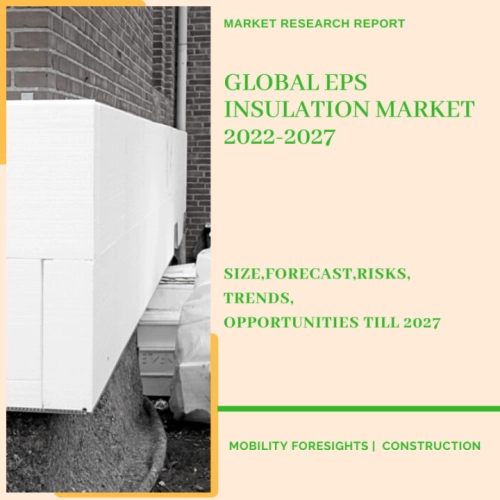
- Get in Touch with Us

Last Updated: Apr 25, 2025 | Study Period: 2022-2027
Improved insulation in both different types of buildings can result in significant cost savings and energy usage reductions, making it one of the most practical and affordable solutions to increase a building's energy efficiency.

Both XPS and EPS perform well in terms of thermal conductivity. The materials used to construct a building's envelope frequently affect how energy-efficient it is. In order to achieve the needed insulation performance, it is imperative to choose the proper insulation type.
Due to EPS's many advantageous properties, including its superior thermal insulation, lightweight, chemical inertness, and bacterial and insect resistance, the product demand in construction applications is anticipated to experience significant rise throughout the projection period.
The global pandemic has had a significant impact on the expansion of the construction industry. A reduction in the growth of the construction industry has resulted in mobility restrictions, production halts, labour shortages, and project cancellations or delays.
These factors are expected to affect demand for EPS in construction applications. Green building is expanding because to government programmes like the State Council Green Building Action Plan and the 13th Five-Year Plan for Building Energy Efficiency and Green Building Development.
Over the course of the forthcoming years, the market's growth is anticipated to be aided by the rising demand for environmentally friendly, lightweight products that offer superior durability along with increased thermal insulation.
It is anticipated that the demand for high-quality polymers will rise as a result of the increasing need for thermal and acoustic insulation in the building and construction sector in developing nations like China and India. Additionally, there are more people creating long-lasting business and residential structures.
BASF is a leading mobiliser of the equipment in the market. The latest integration has been the Expandable polystyrene (EPS) grade with 5.3 percent pentane content and reinforcement from loose filler. It is made using polymerization. Low density, good process ability, and resistance to ageing and degradation.
provides exceptional adaptability, high eco- and cost-efficiency, and effective thermal insulation. It has been designed for pre-expansion, intermediary storage and extension stages of treatment by foams. The compacted raw material is converted into closed-cell foam, which has a low energy need, during the pre-expansion stage.
Nova Chemicals is part of the component manufacture trending companies in the current industry. The DYLITE resin from NOVA Chemicals is a market-leading expandable polystyrene (EPS) resin with exceptional physical qualities, low energy consumption, and FDA-compliant products.
It is appropriate for a wide range of markets and applications, including building and construction, geofoam, packaging, and cup and container, thanks to its lightweight and shown performance. Our products help our clients build dependable, secure, and long-lasting goods.
| Sl no | Topic |
| 1 | Market Segmentation |
| 2 | Scope of the report |
| 3 | Abbreviations |
| 4 | Research Methodology |
| 5 | Executive Summary |
| 6 | Introduction |
| 7 | Insights from Industry stakeholders |
| 8 | Cost breakdown of Product by sub-components and average profit margin |
| 9 | Disruptive innovation in the Industry |
| 10 | Technology trends in the Industry |
| 11 | Consumer trends in the industry |
| 12 | Recent Production Milestones |
| 13 | Component Manufacturing in US, EU and China |
| 14 | COVID-19 impact on overall market |
| 15 | COVID-19 impact on Production of components |
| 16 | COVID-19 impact on Point of sale |
| 17 | Market Segmentation, Dynamics and Forecast by Geography, 2022-2027 |
| 18 | Market Segmentation, Dynamics and Forecast by Product Type, 2022-2027 |
| 19 | Market Segmentation, Dynamics and Forecast by Application, 2022-2027 |
| 20 | Market Segmentation, Dynamics and Forecast by End use, 2022-2027 |
| 21 | Product installation rate by OEM, 2022 |
| 22 | Incline/Decline in Average B-2-B selling price in past 5 years |
| 23 | Competition from substitute products |
| 24 | Gross margin and average profitability of suppliers |
| 25 | New product development in past 12 months |
| 26 | M&A in past 12 months |
| 27 | Growth strategy of leading players |
| 28 | Market share of vendors, 2022 |
| 29 | Company Profiles |
| 30 | Unmet needs and opportunity for new suppliers |
| 31 | Conclusion |
| 32 | Appendix |